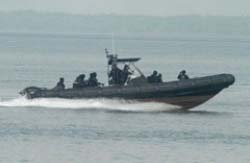Pirate Attacks Double in First Half of 2009

Despite stepped-up naval efforts, piracy on the high seas is raging out of control and the level of violence is rising, a new report finds.
Piracy attacks globally more than doubled to 240 from 114 during the first six months of the year compared with the same period in 2008, according to the report from the ICC International Maritime Bureau’s Piracy Reporting Center (IMB).
"The rise in overall numbers is due almost entirely to increased Somali pirate activity off the Gulf of Aden and east coast of Somalia, with 86 and 44 incidents reported respectively," the report said.
There are signs of a slowdown in waters that have received the most attention from the U.S. Navy and other nations interested in protecting cargo vessels, in part due to the high-profile capture and eventual escape of Capt. Richard Phillips of the Maersk Alabama.
But at the same time, piracy in other waters shot up.
A total of 78 vessels were boarded worldwide in the first half of the year, 75 vessels were fired upon, and 31 were hijacked with some 561 crew taken hostage, 19 injured, seven kidnapped, six killed and eight missing.
The attackers were heavily armed with guns and knives in the majority of incidents.
Get the world’s most fascinating discoveries delivered straight to your inbox.
"Violence against crew members continues to increase," the report concludes.
Nevertheless, the presence of navies in the Gulf of Aden from several countries have made it difficult for pirates to hijack vessels and has led them to seek new areas of operation such as the southern Red Sea and the east coast of Oman, where Somali pirates are believed to be responsible for a spate of recent attacks.
Attacks off the eastern coast of Somalia had decreased in recent months after peaking in March and April, with no attacks reported in June. But the Piracy Reporting Center attributed the decline to heavy weather associated with the monsoons that are expected to continue into August. The Center said vigilance should nevertheless remain high during this period.
Nigeria continues to be a high risk area, with 13 incidents reported in the second quarter to the IMB and at least 24 other attacks which have not been directly reported.
"The majority of attacks are against vessels supporting the oil industry," said IMB Director Pottengal Mukundan. "There is a need for every incident to be reported and brought to the attention of the Nigerian authorities. This is the only way in which the true risk associated to the area can be determined and accurate advice be given to shipmasters, owners and traders."
Attacks in Southeast Asia and the Far East doubled, from 10 in the first quarter to 21 in the second quarter, confirming a similar trend seen in 2008, with the difference being that the attacks in the first quarter were against vessels at anchor, while during the second quarter they were against vessels at sea.
"This is a clear indication that piracy and robbery in Southeast and East Asia has the potential to escalate and shipmasters should remain alert and be aware of the risks involved in the seaway and ports transited during the voyage," Mukundan said.
 Live Science Plus
Live Science Plus






